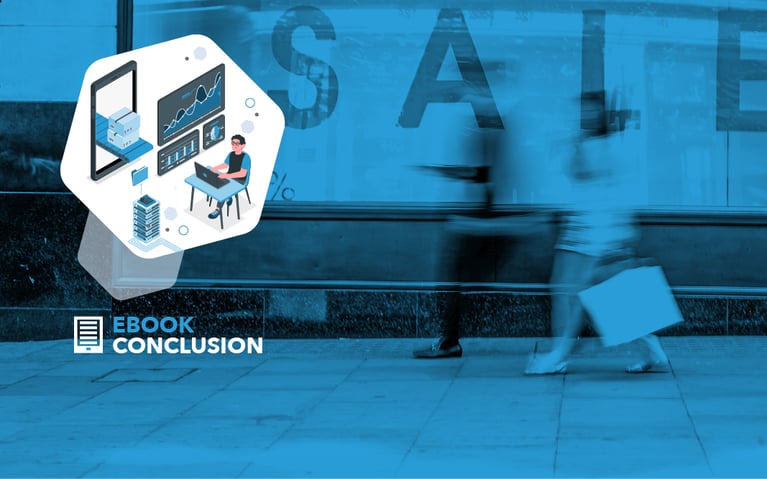The past four years in the fulfillment, logistics and shipping industries have been a wild ride. Thrown into upheaval by the pandemic, the supply chain has since settled – with the occasional disruption – and has also displayed remarkable innovation. Emerging and growing trends are driving changes – many of them likely to remain longer-term. As we enter 2024, staying aware is beneficial so you can take advantage of trends that have changed the supply chain for the better.Here are the top ecommerce supply chain, fulfillment, logistics and shipping trends to watch in 2024:
Economic predictions
The economy is showing many positive signs. From rising wages to decreasing inflation – the outlook feels more optimistic. S&P Global posted its economic predictions for 2024, and they see the downward inflation trend continuing. For shippers, the hope is that revenues and profits can increase without having to raise prices. That said, a volatile oil industry may impact prices and, in turn, the supply chain.
The US is moving into an election year, which creates policy uncertainty. In addition, important elections are occurring in an unusually large number of countries, adding more unpredictability. However, the Inflation Reduction Act subsidies will support growth in the US, although continued financial headwinds to growth are expected. Despite the economical fluctuations, the global supply chain management market was valued at USD 27.2 Billion in 2022 and is projected to reach USD 75.6 Billion by 2032, growing at a CAGR of 10.9% from 2023 to 2032.
Digitalization, AI, blockchain and automation
Digitalized logistics and shipping are an expanding reality for the supply chain. Although some felt it took time for the industry to evolve, a digital transformation has taken over the sector. Companies are adopting cloud computing, IoT connectivity and AI at a rapid pace. The implementation of tools that provide greater supply chain visibility and real-time shipment tracking has benefited the industry greatly.
The next big trend beyond proprietary and cloud-based software, digital platforms, tech stacks, etc., is leveraging machine learning (ML), artificial intelligence (AI), automation, and blockchain to speed up the fulfillment shipping process, reduce costs, improve safety, expand visibility and increase adaptability.
Cybersecurity
In 2017, supply chain cyber attacks impacted 119 entities in the US. In 2022, that number rocketed to 1,743. Cyber attacks will likely increase as the industry digitalizes, meaning companies must invest in preventing attacks and protecting more sensitive data. This will help safeguard cargo and help block operational attacks. Businesses can expect an increase in multifactor authentication, data encryption, risk assessment, continuous monitoring and incident response plans. To stay ahead of a major breach, expect to devote resources to developing best practices and multifaceted strategies to minimize cybersecurity risks.
Last-mile delivery
The continual improvement of last-mile delivery will be at the forefront in 2024. With numerous challenges in the last-mile process, trends will drive changes that aim to improve delivery timeframes.
Expect to see companies prioritize optimizing last-mile logistics. Ecommerce businesses may outsource last-mile services to bolster their delivery network and transportation hubs. They also may try productizing delivery solutions, crowd-shipping, delivery lockers and hubs, advanced technology and looking at ways to keep products closer to customer bases.
With major retailers shaping customer expectations with fast and even same-day delivery – all retailers must be strategic in how they handle their last-mile operations. The customer experience depends on a seamless shipping experience – and the last mile often makes the difference.
Order and delivery methods
Once upon a time, less than 40 years ago, online orders and drone deliveries were something you saw in a sci-fi movie. That reality is now here. The way people order, and businesses deliver have drastically changed. Retailers are integrating multiple sales channels to create seamless customer experiences, requiring omnichannel fulfillment strategies. Additionally, contactless and secure deliveries are becoming more in-demand.
Businesses will need to keep on top of rising consumer demands surrounding order and delivery, and not be afraid to implement the latest methods, like autonomous delivery, personalized experiences, subscriptions and strategies and technologies that blend the physical and digital worlds.
Sustainability
The push for more sustainable and greener business practices continues to influence industry changes. Not only do businesses feel pressure to adopt these practices, but customers are leading the charge. In 2023, 56.8% of consumers said sustainable packaging and shipping were important. And businesses are having to evolve to meet this demand.
In logistics and shipping, look for trends like decarbonization, renewable energy and tech innovations that support demand forecasting, route optimization and track and reduce energy wastage in warehouses and fulfillment centers. Ecommerce businesses will look at ways to reduce packaging and use more eco-friendly materials (e.g., recycled, renewable or compostable).
The industry as a whole faces new regulations. For example, IMO 2020, which proposed that global shipping standards limit Sulphur (S) in fuel oil to 0.5% S (by mass). Some companies are stepping up independently and are committed to achieving net zero – having a zero-carbon footprint by 2040.
Future-proofing your supply chain
If the pandemic proved anything, it’s that the supply chain is vulnerable. Various challenges can emerge at any time. Even in 2023, the supply chain dealt with increased costs, labor shortages, port congestion, consumer demands, cyber attacks, risk, compliance and gaps during digital transformations.
One trend to combat these issues and more is to future-proof your supply chain and plan for inflation, shifting customer expectations, logistics disruptions and demand fluctuations. This can be done by increasing resilience and staying agile. Strategies include everything from diversifying product sources and suppliers to using analytics to identify potential risks and develop associated responses. Supply chain organizations can also shift to a consumer-logistics (tuning into your customers) fulfillment strategy that provides solutions supporting speedier, accurate deliveries that drive retention and loyalty.
Prepare for 2024 fulfillment trends with Cart.com
The ecommerce fulfillment landscape is set to take new turns driven by innovation, consumer expectations and technological breakthroughs in 2024. With these changes comes the imminent ecommerce fulfillment trends that promise to redefine the online shopping experience. Staying competitive is about staying current and being at the forefront of change, which means adapting to industry evolution is essential. By staying agile and resilient in the face of fulfillment challenges and changes, you're better equipped for ecommerce success.
Subscribe to our emails for the latest industry insights!
By entering your email, you agree to receive marketing emails from Cart.com






